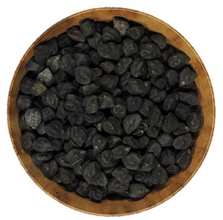Steckbrief
Die Kichererbse, Cicer arietinum, hat ihren Namen nicht, wie vielleicht angenommen, weil sie so witzig ist. Die Bezeichnung „Kicher“ ist auf den lateinischen Begriff „cicer“ für Erbse zurückzuführen. Streng genommen heißt die „Kichererbse“ also eigentlich „Erbseerbse“.


Usage
The chickpea is available dried or precooked in cans and jars. The dried chickpeas must be soaked in water for at least twelve hours, preferably overnight, before cooking. Cooking time varies from 30 to 120 minutes, depending on size and use. Thanks to their nutty flavor, they are suitable for stews, salads, soups and for the oriental dishes falafel (chickpea balls) and hummus (spread made from pureed chickpeas). Chickpea flour is also used as a base for bread, pizza dough or sweet baked goods.
Chickpeas are characterized by their high protein content. They are rich in vitamins, minerals and trace elements such as iron, folic acid and potassium.
In their raw state, chickpeas, like all legumes, contain indigestible phasin, which is destroyed and rendered harmless during cooking.
Botany
The chickpea belongs to the legume family. The annual, herbaceous plant can grow up to one meter high. The erect to decumbent, square stem usually branches from below. Like the leaves, it is blue-green to gray-green in color.
The alternate leaves on the stem are pinnate and have two- to five-pointed stipules at the base. The individual leaflets are obovate, seven to ten centimeters long, strongly serrated in the upper part and covered with sticky glandular hairs.
The ten to twelve millimeter butterfly flowers are solitary in the leaf axils and are white, pink to purple in color.
Chickpeas are basically self-fertilizers, although cross-fertilization occurs occasionally due to insect flight.
The inflated, nodding legume contains one to two unequal seeds, which may be light brown, beige, red, brown or black. Chickpeas are divided into two types: The Kabuli type has larger, roundish, cream-colored seeds and is better known and more common in Europe. The Desi type has small, wrinkled, dark seeds and is popular in India.
Agricultural aspects
According to the AMA area analysis, chickpeas were grown on 381 ha in Austria in 2023.
Chickpeas thrive best in warm and sunny climates with good rainfall distribution during the growing season. They have a high germination water requirement. The minimum germination temperature is 5 °C, the optimum is 25 °C. Although it is sensitive to frost, it is drought-resistant and tends to suffer from excessive moisture. Chickpeas therefore cope well with the changed climate.
The plants prefer calcareous, sandy loam soils and also grow on poor, dry soils where other crops fail due to a lack of nutrients. They are usually sown at the end of April to mid-May, when there is no longer any risk of frost, at a depth of 5-8 cm and at a row spacing of 30-35 cm. As chickpeas are only weakly competitive against weeds, weeds must be removed regularly at the beginning, e.g. by harrowing or hoeing.
A cultivation break of at least five years must be observed with any other legumes (legume fatigue; this term refers to the complex of several foot diseases in the soil, the interaction of which leads to a reduction in yields). However, chickpeas are good preceding crops, especially for low-yielding cereals. Due to the nitrogen fixation of the symbiotic nodule bacteria, nitrogen applications are generally not necessary.
Harvesting takes place from the end of August to September. As chickpeas are very sturdy and their pods do not burst easily, they can be harvested using a combine harvester.
Yield potential of chickpea in Austria
Chickpea is currently still little cultivated in Austrian agriculture, although demand has increased steadily in recent years. Many Austrian farmers lack the appropriate seeds and practical knowledge to cultivate chickpeas. Currently, no chickpea variety is listed in the Austrian variety list. Therefore, we want to support agriculture with a project in which the (yield) potential of chickpeas is determined with a variety trial and further expertise is built up and passed on.
Last updated: 09.10.2025
automatically translated